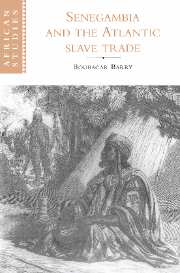Book contents
- Frontmatter
- Contents
- Preface
- Map
- I Senegambia from the fifteenth to the seventeenth century: a haven for incoming populations, a station for migrants on the move
- 1 Senegambia in the fifteenth and sixteenth centuries: dependence on the Sudan and the Sahara
- 2 Social dynamics in Senegambia
- 3 The Atlantic trading system and the reformation of Senegambian states from the fifteenth to the seventeenth century
- 4 The partition of the Senegambian coast in the seventeenth century
- II Senegambia in the eighteenth century: the slave trade, ceddo regimes and Muslim revolutions
- III Senegambia in the first half of the nineteenth century: legitimate trade and sovereignty disputes
- IV Senegambia in the second half of the nineteenth century: colonial conquest and resistance movements
- Conclusion
- Notes
- Bibliography
- Index
- Other books in the series
1 - Senegambia in the fifteenth and sixteenth centuries: dependence on the Sudan and the Sahara
Published online by Cambridge University Press: 31 October 2009
- Frontmatter
- Contents
- Preface
- Map
- I Senegambia from the fifteenth to the seventeenth century: a haven for incoming populations, a station for migrants on the move
- 1 Senegambia in the fifteenth and sixteenth centuries: dependence on the Sudan and the Sahara
- 2 Social dynamics in Senegambia
- 3 The Atlantic trading system and the reformation of Senegambian states from the fifteenth to the seventeenth century
- 4 The partition of the Senegambian coast in the seventeenth century
- II Senegambia in the eighteenth century: the slave trade, ceddo regimes and Muslim revolutions
- III Senegambia in the first half of the nineteenth century: legitimate trade and sovereignty disputes
- IV Senegambia in the second half of the nineteenth century: colonial conquest and resistance movements
- Conclusion
- Notes
- Bibliography
- Index
- Other books in the series
Summary
A defining feature of the Senegambian zone is its geographical location between the Senegal and the Gambia Rivers, far from the Niger Bend. A second is its position between the Sahara desert and the tropical forest zone. This dual intermediary location made Senegambia dependent on the states of the Sudan and the Sahara until the fifteenth century. Only later, with its opening out onto the Atlantic seaboard, did the region begin to play its pivotal geographical role in full. To this day it continues to play that role, serving the West as a gateway for economic and political penetration into the African hinterland.
The zone is home to a great diversity of peoples: these include Wolof, Peul, Tukulor, Manding, Sereer, Soninke, Susu, Joola, Nalu, Baga, Beafada, Bainuk, and Basari. The cultural unity underlying this diversity comes from centuries spent living together. The organization of economic, political, and social life here bears strong traces of influence from old Mali and the Muslim religion. These influences were decisive in the transition of Senegambia's societies from kin-based political forms such as the lamanal or the kafu to the organization of monarchical states.
Geographically, Senegambia lies wholly within the tropical zone between the Sahel and the forests of Guinea. Two rivers, the Senegal and the Gambia, both underpin and symbolize the region's geographical unity. Both spring from the same upland mass, the Futa Jallon plateau.
- Type
- Chapter
- Information
- Senegambia and the Atlantic Slave Trade , pp. 5 - 25Publisher: Cambridge University PressPrint publication year: 1997

